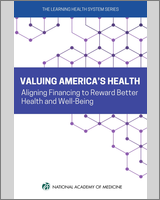NCBI Bookshelf. A service of the National Library of Medicine, National Institutes of Health.
National Academy of Medicine; The Learning Health System Series; Hunt A, Anise A, Chua PS, et al., editors. Valuing America’s Health: Aligning Financing to Reward Better Health and Well-Being. Washington (DC): National Academies Press (US); 2024 Feb 12.

Valuing America’s Health: Aligning Financing to Reward Better Health and Well-Being.
Show detailsIn the spring of 2021, under the auspices of the National Academy of Medicine’s (NAM’s) Leadership Consortium in collaboration with the National Academies of Sciences, Engineering, and Medicine’s (the National Academies’) Health and Medicine Division, a 3-day workshop series titled Financing That Rewards Better Health and Well-Being was held (NASEM, 2021). A Proceedings of a Workshop—in Brief (PIB), which highlighted presentations and discussions from the workshop, was published in September 2021 (NASEM, 2021). Important themes from the workshop, as interpreted by authors of this publication, as well as proposed implementation actions from the PIB are briefly summarized below.
WORKSHOP THEMES
- 1.
The current system of paying for health care is not designed to reward improved health outcomes and is especially inadequate in advancing the health of vulnerable populations with low incomes.
- 2.
Policies and strategies that encompass both clinical and nonclinical approaches that can promote optimal health and well-being exist, but they are limited in scope and scale, which limits their growth and sustainability in the current payment system.
- 3.
New funding and finance strategies are needed to disrupt dysfunctional health care delivery pathways and support approaches that work to improve health.
- 4.
Effective approaches to improving health will necessitate more than innovative care models and sometimes lie entirely outside the health and health care sectors.
Reimagining Approaches to Care for the Entire Population
- Integrate services that drive health and well-being.
- Extend domains of care to encompass communities.
- Invest in health care and social supports for infants and children to address health disparities that occur early in life.
- Engage in effective life-stage care strategies.
- Provide high-quality care to older adults and individuals with disabilities.
- Expand the use of home- and community-based services.
- Make full use of telehealth, virtual health, and other technologies.
Redesigning Health Financing to Focus on Producing Whole Person and Whole Population Health and Well-Being
- Establish health system accountability based on meaningful quality measures.
- Invest in a workforce that can provide whole person and whole population health.
- Leverage state, local, and federal funding opportunities to experiment, authorize, assess, and extend care delivery and financing innovations.
- Set longer time horizons for returns on investments in health.
- Use universal empanelment1 to provide high-quality primary care.
- Use lessons from the COVID-19 pandemic to recognize gaps and the fragility of fee-for-service financing strategies, and transition away from their use.
- Connect the public- and private-sector producers of better health with the entities interested in investing in better health to direct resources to address the social determinants of health.
- Shift resources toward vulnerable populations with low incomes to improve population health and lower the costs of health care.
- Leverage market forces to aid the health system in moving away from fee-for-service financing structures.
- Implement mandatory payment strategies that do not operate on fee-for-service business models.
- Eliminate frictional costs2 and “gaming the system.”
Cross-Cutting Suggestions
- Ensure that equity is a major driver of transformed health care delivery and financing.
- Study how relationships in complex systems give rise to collective behaviors to learn how to redirect those systems.
- Create a shared digital infrastructure to enable better communication, coordination, data sharing, and strategic investments.
- Build on collaborative, cross-sector partnerships to advance better health and well-being.
- Ensure that patients are at the center of payment and care.
REFERENCES
- Bearden T, Ratcliffe HL, Sugarman JR, Bitton A, Anaman LA, Buckle G, Cham M, Chong Woei Quan D, Ismail F, Jargalsaikhan B, Lim W, Mohammad NM, Morrison ICN, Norov B, Oh J, Riimaadai G, Sararaks S, Hirschhorn LR. Empanelment: A foundational component of primary health care. Gates Open Research. 2019;3:1654. https://doi
.org/10.12688/gatesopenres .13059.1 . [PMC free article: PMC7134391] [PubMed: 32529173] - NASEM (National Academies of Sciences, Engineering, and Medicine). Financing That Rewards Better Health and Well-Being: Proceedings of a Workshop—in Brief. Washington, DC: The National Academies Press; 2021a. https://doi
.org/10.17226/26332 .
Footnotes
- 1
Empanelment refers to a “continuous, iterative set of processes that identify and assign populations to practices, care teams, or clinicians that have a responsibility to know their assigned population and proactively deliver coordinated primary care” (Bearden et al., 2019; NASEM, 2021, p. 312).
- 2
Frictional costs refer to the total financial transaction costs—both direct and indirect—incurred beyond the actual cost of the service or product.
- FINANCING THAT REWARDS BETTER HEALTH AND WELL-BEING WORKSHOP SERIES PARTICIPANT ...FINANCING THAT REWARDS BETTER HEALTH AND WELL-BEING WORKSHOP SERIES PARTICIPANT SUGGESTIONS - Valuing America’s Health
Your browsing activity is empty.
Activity recording is turned off.
See more...